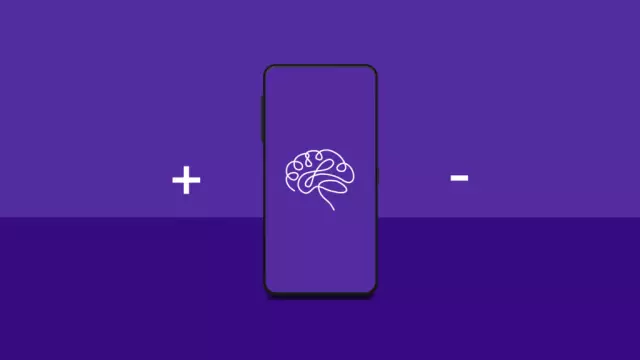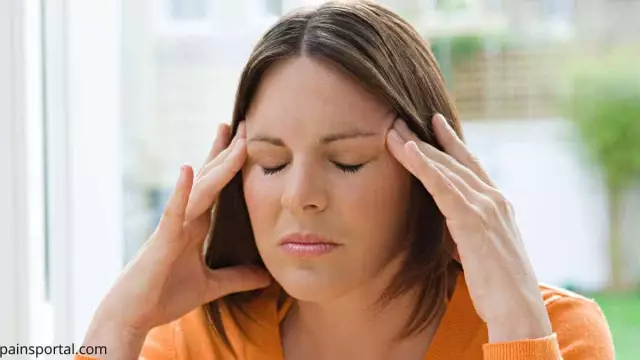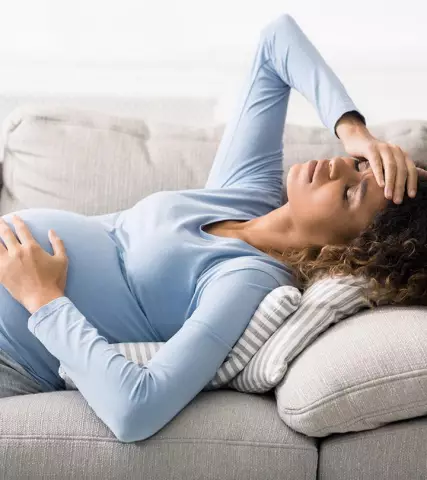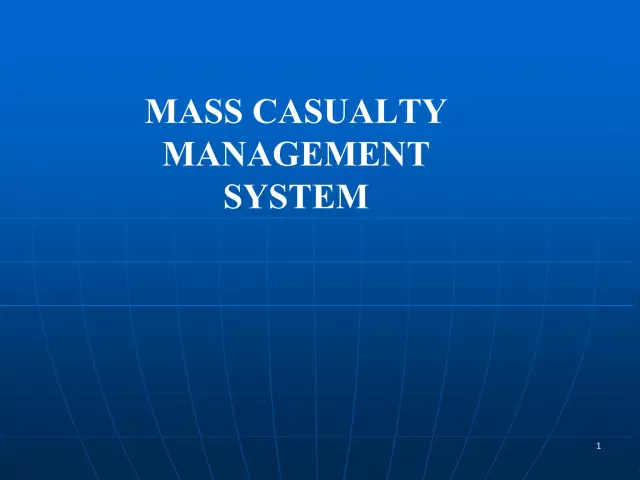- Author Rachel Wainwright [email protected].
- Public 2023-12-15 07:39.
- Last modified 2025-11-02 20:14.
Headache: causes and methods of struggle
According to statistics, seven out of every ten patients complain of headaches when visiting doctors. In fact, there are many more people who periodically experience unpleasant sensations of this kind.

Source: depositphotos.com
Many, not counting the headache as a cause for serious concern, prefer to independently drown out the next attack with medications. This is an extremely reckless behavior, especially if the symptom appears regularly and is accompanied by some other. Constant headaches almost always indicate a problem that requires specialist intervention.
Pain in the temples
When determining the causes of headache, one of the main diagnostic signs is the localization of unpleasant sensations. Pain in the temporal regions may result from:
- violations of vascular tone (cerebral angiodystonia). The pain is aching, dull. It starts at the temples but can spread to other areas of the head, neck, and upper back. Attacks happen at any time of the day. Patients complain of weakness in the limbs, numbness of the fingers, tinnitus, dizziness, weakening of the sense of smell and memory, insomnia;
- autonomic dysfunctions. Then the pain is accompanied by tinnitus, dizziness, fainting;
- increased intracranial pressure. Concomitant symptoms - nausea, vomiting, visual impairment. The disease is very dangerous. In the absence of qualified assistance, disorders of consciousness, seizures and other serious complications may occur;
- arterial hypertension. If pain (especially in an elderly person) is associated with stress, changes in weather conditions, overwork, it is likely that it is caused by high blood pressure. In such cases, pain in the heart, shortness of breath, weakness, heaviness and noise in the head often appear;
- atherosclerosis. Obsessive headaches often occur against the background of pathological narrowing of the blood vessels in the brain. At the same time, memory gradually weakens, a person experiences constant fatigue, is irritated for no reason;
- temporal arteritis (an inflammatory process in the membranes of the carotid and temporal arteries), which often becomes a consequence of influenza or ARVI. The pain in the temples is severe, throbbing. The intensity increases in the second half of the day and at night, when you touch the skin of the temples, talking, chewing. An increase in body temperature is characteristic;
- migraine. Sharp, throbbing pain that is often localized to only one side. It is accompanied by phobia and sound, nausea, painful reaction to odors, drowsiness, irritability, depression, or overexcitation. Attacks occur intermittently and can last for several hours. In many cases, there is a hereditary predisposition to the disease;
- cluster pain. Unpleasant sensations begin with congestion in one ear, then there is a sharp pain in the temple and in the eye area, which is accompanied by lacrimation. The attacks occur several times during the day. This condition lasts for several weeks, and then disappears without a trace. The disease usually manifests itself in the spring and summer;
- trigeminal neuralgia. A chronic disease characterized by severe, shooting pain that spreads along one side to the cheek, lips, teeth, ear, and eyes. An attack can be triggered by chewing, washing your face, brushing your teeth, or simply touching your skin. Often accompanied by unilateral facial muscle spasm.
In addition, temporal lobe headaches can occur during menstruation or in menopause in women, with fatigue and overexertion, or be a distant consequence of head injuries.
Occipital pain
A significant part of patients who complain of pain in the back of the head suffer from various diseases of the cervical spine (spondylosis, osteochondrosis) or inflammatory processes in the muscles of the neck (for example, myositis). With all these ailments, there is a significant limitation of neck mobility, the pain extends to the area behind the ears and the upper back. Typically, patients experience physical stiffness and sleep disturbances. With osteochondrosis, pain can be accompanied by tinnitus, nausea, and imbalance.
Pain in the back of the head is often a sign of increased blood or intracranial pressure. Sometimes such sensations are associated with problems with blood vessels (for example, with a slowdown in the outflow of venous blood from the head). These cases are characterized by increased pain when lying down and coughing, morning swelling of the lower eyelids.
Dull pain in the back of the head often occurs in people who are forced to be at work for a long time in a position associated with the tension of the neck muscles (drivers, seamstresses, watchmakers, programmers, jewelers, etc.). Unpleasant sensations of this type are also a consequence of stress.
Frontal head pain
When pain is localized in the forehead, the cause may be:
- household poisoning. We are talking about intoxications associated with excessive consumption of alcohol, and about poisoning by substances that are released into the air by furniture, plastic, construction and finishing materials, clothes treated with low-quality paints. Food additives, which are abundant in industrial products and drinks, can have a similar effect on the body;
- inflammatory diseases of ENT organs (frontal sinusitis, sinusitis, etc.);
- infectious and viral diseases (influenza, ARVI, meningitis, various fevers);
- neuroses;
- pathology of the cardiovascular system. In this case, a headache can be triggered by both increased and decreased intracranial pressure;
- eye diseases (including those associated with high intraocular pressure);
- malignant neoplasms.
Headache treatment
In most cases, headache is not an independent disease, but a symptom of some kind of ailment. The main role in getting rid of unpleasant sensations is played by the correct diagnosis, which allows you to prescribe the optimal treatment.

Source: depositphotos.com
Trying to relieve seizures with self-selected pain relievers is permissible only in cases where the headache occurs very rarely and is not accompanied by other signs of malaise. It is worth mentioning that sometimes drugs taken without the supervision of a doctor become the cause of the onset and intensification of pain. If unpleasant sensations appear infrequently, it is worth trying to solve the problem without using medications, for example, to do a gentle massage, take a contrast shower, drink a soothing mint tea.
It is necessary to consult a specialist in a situation when the headache is accompanied by vomiting, visual or hearing impairment, dizziness, fever, speech disorder or coordination of movements, weakness. Consultation with a specialist is required if an unpleasant symptom occurs at regular intervals or the attacks continue despite taking medication. Remember that treating a headache as a minor nuisance can be hazardous to your health.
YouTube video related to the article:

Maria Kulkes Medical journalist About the author
Education: First Moscow State Medical University named after I. M. Sechenov, specialty "General Medicine".
Found a mistake in the text? Select it and press Ctrl + Enter.






